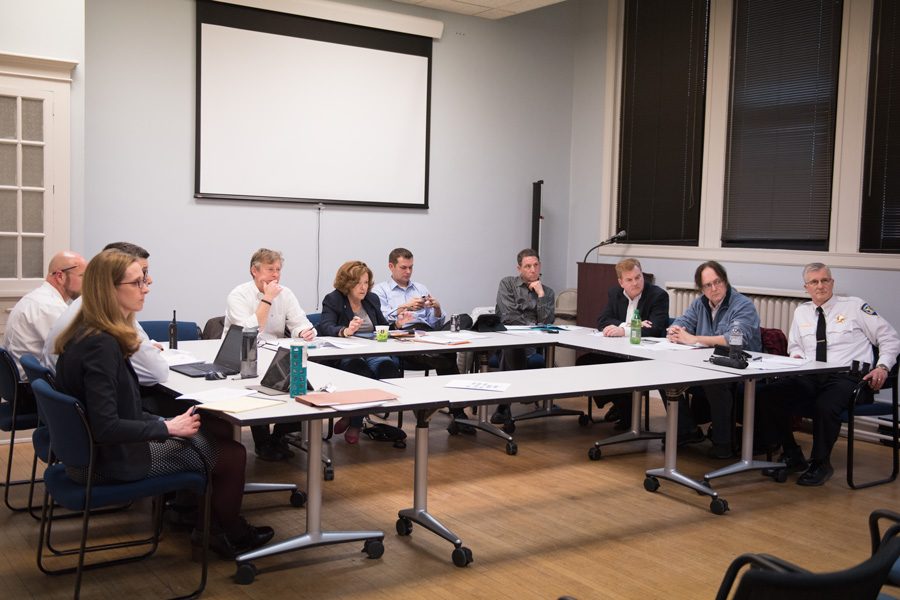Subcommittee urges clarity in nuisance property ordinance language
Lauren Duquette/Daily Senior Staffer
Members of the Nuisance Integrity Ordinance subcommittee discuss possible changes to the ordinance Wednesday night. Landowners at the meeting brought up concerns over the punishment process in the proposed ordinance.
April 21, 2016
A subcommittee discussed how to revise an ordinance addressing Evanston’s nuisance properties Wednesday night, focusing on the necessity of clearly outlining what factors will determine if a property is labeled as a problem.
This was the second meeting of the Neighborhood Integrity Ordinance subcommittee, which was formed last month to revise the ordinance. The ordinance was introduced earlier this year to revise the existing rules to address buildings with significant crime issues and building code violations that are deemed “nuisance properties.”
Council moved to form the subcommittee to address the ambiguous wording and unclear punishment processes of the proposed revised ordinance. The ordinance proposed earlier this year would have designated a property a nuisance if there were two or more arrests on the property within a six month period.
The proposed ordinance should more clearly lay out which properties need to be addressed, Evanston Police Chief Richard Eddington said.
“When you put the standard at arrest, we’re subtracting a substantial number of issues that are problematic for the neighborhood,” he said.
Members of the subcommittee raised concern that the ordinance could inhibit Evanston residents from calling the police if there was crime on their property, such as domestic violence cases, because it could mean they would be placed on the list of nuisance premises.
Eddington said there should be a balance between designating properties a nuisance if there are arrests there and if there are a significant number of calls for service.
Amy Meek, a staff attorney with the American Civil Liberties Union of Illinois, said at the meeting that the city should avoid including calls for service as a way a property could be designated a nuisance.
“In general we have concerns about the chilling effects that this has on tenants with willingness to call the police,” she told The Daily. “The tendency is to want to have the broadest possible tools, but then you bring in a lot of people who are not really nuisances.”
Also under the previously proposed ordinance, landlords would have been held accountable for addressing the issues at their properties. This part of the proposal received backlash from community landlords who felt it was unfair to make them responsible for tenants whom they could not control.
Ald. Ann Rainey (8th) said city properties should be inspected on a more timely basis, which would not necessarily be addressed in a proposed nuisance ordinance, but should still be a priority of the city.
“Decent housing and crime-free neighborhoods, neighborhood integrity, it all goes together,” she said.
Current city code requires buildings that receive Community Development Block Grants — or federal funds used to provide adequate housing to low- and moderate-income individuals — be inspected every three years, while other buildings are required to be inspected every four to six years, Carl Caneva, the assistant director of Evanston’s Health and Human Services department told The Daily. A minimal number of inspectors — four for 2,500 buildings — and a faulty software program that tracks which buildings need to be inspected, makes it difficult to do this, Caneva said.
A flowchart of how the ordinance would address nuisance premises prepared by city staff emphasized communication with landlords.
“The idea here is to give everybody a visualization of the path that these people take,” Ald. Donald Wilson (4th) said. “The city’s expectation would be that … there would be a meeting with the owner to develop a plan on how to deal with the problem”
Email: [email protected]
Twitter: @noracshelly


